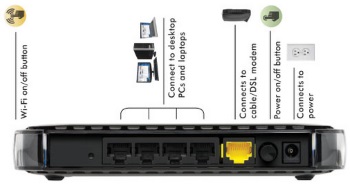How to Connect a Wireless Router
By David W Christie
When connecting a Wireless Router to the Internet and to provide a WLAN (Wireless Local
Network) for local connectivity, it is important that you first have a working Broadband
DSL connection to the Internet via a DSL modem. A lot of non-technical people get confused
about the difference between a wireless router and an Internet Gateway Router, which has a
built-in modem and so does not need a standalone DSL modem.
Let us assume you already have a DSL Modem and you have tested connectivity to the Internet
through the modem with a PC. Now we need to connect the wireless router to the DSL Modem and
also set up the local Wireless LAN to enable local devices to connect wirelessly with the device.
If you have a cable modem, because your broadband service from your Internet Service Provider
is a cable service then the setup is very similar, having already tested the functionality
of the Cable Modem.
In order to connect to the wireless router, your PCs, Notebooks or even
Gaming Consoles need to support the IEEE 802.11 wireless standards. In other words they must
have a wireless NIC card either built-in to the Motherboard or you will need to purchase a
wireless adapter, the most common being USB Wireless Adapters which are largely Plug and Play.
Another important thing to remember when purchasing your wireless router, is to make
sure it is not a wireless access point, otherwise it will not have the routing function which
essential to connect your wireless devices to the Internet.
We are almost ready to start connecting our wireless device, so it would be a good idea
to have a copy of any set-up instructions that came with the device. They will be very similar,
regardless of the manufacturer, but there will be subtle differences.
Switch off or unplug your existing DSL Modem or Cable Modem. If it is a DSL Modem then
it will be connected to a telephone point with a supplied telephone cable, usually via an ADSL
filter. Next take the network cable supplied with your wireless router and plug one end into
the RJ-45 receptacle on the DSL Modem (there will usually only be one). Connect the other end
of the cable into the WAN port on your wireless router.


Most wireless routers also have 4 ports to enable you to connect 4 separate PCs via cables.
The WAN port is normally distinct from the computer ports my means of colour coding or due
to the fact that it is separate from the other 4 ports.
The next step is to plug in and switch on the DSL Modem and wait few minutes to enable
it to boot and then synchronise with the Service Provider network via the telephone cable.
Your DSL Modem will normally have a visible LED indicating a successful connection to the Internet.
Now switch on your wireless routing device that you previously connected to the DSL Modem,
and shortly a green LED will normally indicate successful connection to your Modem. We are
now almost ready to start configuring the Wireless Router itself.
Use a network patch cable to connect a working PC to one of the usually 4 network ports
on the wireless device. A built-in DHCP Server in the wireless router should allocate an appropriate
IP Address to the PC being used for configuration. Open up a browser window on your PC and
type in the URL provided by the manufacturer in the address bar. For example Linksys routers
normally use the URL
http://192.168.1.1/
Success should result in the router default configuration page becoming visible in your
browser window. Your router instructions should give you the default username and password
required to access the main wireless router configuration. This will often be admin and admin,
or whatever your router instructions informs you.
| 
